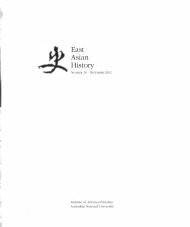Mujaku Dochu (1653-1744) and 17th-Century ... - East Asian History
Mujaku Dochu (1653-1744) and 17th-Century ... - East Asian History
Mujaku Dochu (1653-1744) and 17th-Century ... - East Asian History
You also want an ePaper? Increase the reach of your titles
YUMPU automatically turns print PDFs into web optimized ePapers that Google loves.
MUJAKU DOCHO<br />
37<br />
age of twenty. These included The Revealing Mirror of Ch 'an by Sosan<br />
Hyujong <strong>and</strong> two works by Yun-ch'i Chu-hung (1535-1615). The last was<br />
The Beginning Vinaya Studies CLU-hsueh fa-jen 1$l!W) by Yung-chUeh<br />
Yuan-hsien (1578-1657), which he read at the age of 92 in <strong>1744</strong>. He even<br />
wrote a commentary on the Semantic Commentary on the Lankiivatiira<br />
Sutra CLeng-ch'ieh ching i-shu m11JO#UfrD by Chih-hsu, which he first<br />
read in 1743 at the age of 91. 6 3 At a rough count Csome works are divided<br />
in the catalogues, others combined), <strong>Mujaku</strong> read 85 works, Buddhist <strong>and</strong><br />
non-Buddhist from the Ming <strong>and</strong> Ch'ing periods, plus four works from<br />
Choson Korea. Possibly the latest Buddhist figure of Ch'ing Buddhism<br />
that <strong>Mujaku</strong> read was Tao-p'ei (1615-1702), whose Ten Tr easures fr om<br />
the Ocean of Ch 'an CCh'an-hai shih-chen t-'mJ+Jt) of 1687 he read in<br />
1743. 6 4<br />
Ibusshorin, 1975), p.419ff., for a paI1ial list;<br />
for <strong>Mujaku</strong>, see lida, Gakusha<strong>Mujaku</strong>DachU,<br />
after each year of<strong>Mujaku</strong>'s life from the age of<br />
42, <strong>and</strong> for before age 42, see Ugen rijin.<br />
63 Ugen rijin, age 20, when he read Chuhung's<br />
Ch 'an-kuan ls 'e-chin, an influential<br />
work, <strong>and</strong> the Yiin-ch 'i fang-sheng wen<br />
[YOn-ch'i's Text on the Release of Animals!;<br />
for YOan-hsien's work, Lii-hsiieh fa -jen, see<br />
!ida, GakushO <strong>Mujaku</strong> Dachii, p.292, <strong>and</strong><br />
the work by Chih-hsO, see !ida, Gakusha<br />
<strong>Mujaku</strong> Dachu, pp.285, 316.<br />
64 !ida, GakushO<strong>Mujaku</strong> Dachu, p.285; Yanagida<br />
Seizan, "Zenseki kaidai" [Explanations<br />
of Titles of Ch'an Texts! in Zenke lOVER<br />
While it is sometimes asserted that Hakuin (1642-<br />
1741) attempted to revive Sung dynasty-style Ch'an/Zen,<br />
he too was inspired sometime after 1703 by The Goads<br />
to Advance One Through the Ch 'an Barrier CCh'an-kuan<br />
ts'e-chin t-' ) of 1600 by Chu-hung. 6 5 This book<br />
had been read by <strong>Mujaku</strong> in 1672, <strong>and</strong>, later Hakuin<br />
<strong>and</strong> <strong>Mujaku</strong> were occasional correspondents. 66 Likewise,<br />
The Precedents of the TS 'ao-tung Sect of 1644<br />
by Yuan-hsien inspired a revival of studies of the five<br />
ranks (go 'i 1i ilL) by the Soto Zen school. Notably, it was<br />
Baiho Jikushin (1633-1707) who had this text reprinted<br />
in 1680. 6 7 As we have seen, Jikushin was the teacher<br />
of <strong>Mujaku</strong>'s mother, who became a nun, <strong>and</strong> <strong>Mujaku</strong><br />
treated Jikushin as a mentor <strong>and</strong> wrote a commentary<br />
on one of Jikushin's works. <strong>Mujaku</strong> also referred to<br />
The Precedents of the TS 'ao-tung Sect. 68 CSee Figure 6<br />
overleaO Even the Jodo monk, Myoryu 9 (1705-86)<br />
understood the positions of Chu-hung <strong>and</strong> Chih-hsu<br />
on nenbutsu 0odo) <strong>and</strong> Man CZen), 69 <strong>and</strong> a leading<br />
member of the Sorai school of Confucianism, Hattori<br />
Nankaku $1¥i¥ (1683-1759), noted a Chu-hung<br />
work, possibly for its poetry 70<br />
Furthermore, a number of works by Chu-hung,<br />
Chih-hsu <strong>and</strong> Yuan-hsien were republished in the early<br />
Tokugawa period, <strong>and</strong> are still available in booksellers'<br />
catalogues to this day. In the 2005 catalogue of Kobayashi<br />
shobo IN;t:m:m, I counted six works by Chuhung,<br />
five by Chih-hsu Cplus two undated) <strong>and</strong> four by<br />
Yuan-hsien, the earliest dated from the year of <strong>Mujaku</strong>'s<br />
birth (<strong>1653</strong>) <strong>and</strong> the last from between 1716 <strong>and</strong><br />
1735.71 From my own collection <strong>and</strong> that of the Zen-<br />
Figure 5<br />
7he Ch'an-hai shih-chen by Tao-p 'ei in aJapanese imprint<br />
0/ 1695<br />
t <br />
1<br />
t f Clb<br />
i;, .f-<br />
!iL<br />
If t<br />
1- 1i<br />
2t, th

















